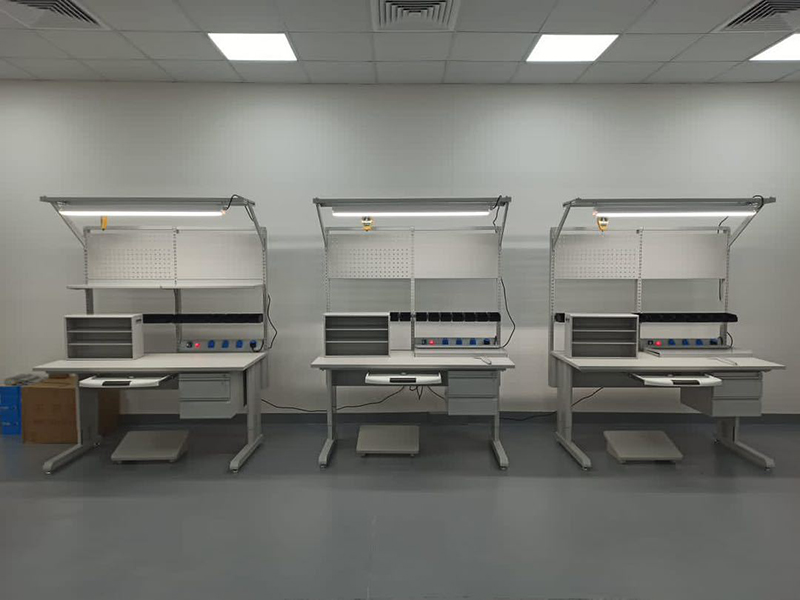Table of Contents
Setting up an ESD (Electrostatic Discharge) workbench is crucial for protecting sensitive electronic components from potential static damage. Whether you’re setting up a static-safe workspace for the first time or looking to improve your current configuration, it’s important to avoid common pitfalls that can compromise your anti-static environment.
As an expert in ESD workbench setup, this guide will help you identify and prevent the top mistakes people often make when creating a static-safe workspace, ensuring that your setup is as effective and efficient as possible.
Neglecting Proper Grounding
One of the most common and serious mistakes in setting up an ESD workbench is failing to properly ground the workspace. Grounding is the process of connecting the workbench and other components to a ground point, which safely dissipates static charges.
Why This Is a Mistake:
If your workbench isn’t grounded, static electricity can accumulate on the surface or surrounding equipment, increasing the risk of electrostatic discharge. This can lead to costly damage to sensitive electronics.
How to Avoid It:
- Use Proper Grounding Cables: Make sure that all ESD workbenches are connected to a verified ground point using the appropriate cables.
- Test Grounding Regularly: Use an ESD tester to check that the grounding system is working correctly. This includes testing wrist straps, mats, and any other equipment connected to the ground point.
Ensuring proper grounding is essential in preventing ESD workbench setup mistakes that could lead to static damage.
Choosing the Wrong Workbench Materials
Not all workbench surfaces are suitable for an ESD-safe environment. Using non-ESD materials like wood, plastic, or untreated metal can cause static to build up, even if the workspace is otherwise well-equipped.
Why This Is a Mistake:
Non-ESD surfaces can generate or retain static, making them dangerous for working with electronics. Even small amounts of static can cause irreversible damage to components.
How to Avoid It:
- Use ESD-Safe Materials: Choose workbenches specifically designed with anti-static properties. Look for surfaces that are static-dissipative or static-conductive to minimize charge buildup.
- Add ESD Mats If Necessary: If you already have a workbench without static-safe properties, add ESD mats to the surface to create a protective layer that reduces static.
Selecting the right anti-static workbench materials ensures that your workspace remains safe from static buildup.
Forgetting to Control Humidity Levels
Humidity levels play a significant role in static generation. Dry air can increase static buildup, while too much moisture can create an environment that’s unsafe for electronics.
Why This Is a Mistake:
In environments with low humidity, static electricity tends to build up more easily. If humidity is not controlled, your ESD workbench setup may be ineffective even if everything else is in place.
How to Avoid It:
- Maintain Optimal Humidity: Keep the humidity in your workspace between 40% and 60%. Use a humidifier in dry climates to reduce static generation.
- Monitor Conditions Regularly: Use a hygrometer to measure humidity levels and ensure that they stay within the optimal range for static-safe environments.
Maintaining proper humidity control is crucial for avoiding static-safe workspace errors and ensuring that your ESD setup is effective.
Improper Use of ESD Wrist Straps
ESD wrist straps are a key component in an anti-static workspace, but they are often misused or neglected. Without proper wrist strap usage, static from the worker’s body can easily discharge into sensitive electronics.
Why This Is a Mistake:
Workers may forget to wear their wrist straps, or they might use damaged straps that no longer function properly. Additionally, straps that are not connected to a ground point are ineffective.
How to Avoid It:
- Wear Wrist Straps at All Times: Make it a rule that anyone handling electronics in the workspace must wear an ESD wrist strap.
- Test Wrist Straps Regularly: Use an ESD tester to check that wrist straps are functioning correctly and are properly connected to a ground point.
- Use Continuous Monitoring Systems: For added protection, consider using a continuous monitoring system that alerts workers if the wrist strap becomes disconnected or fails.
Proper use of ESD wrist straps is key to preventing ESD workbench setup mistakes related to personal static discharge.
Not Testing ESD Equipment Regularly
Even the best ESD setup can become ineffective if it isn’t tested regularly. Over time, grounding points, wrist straps, and mats can wear out, leading to reduced protection against static discharge.
Why This Is a Mistake:
Many people assume that once their ESD setup is complete, it will continue to work indefinitely. However, without routine testing, you may not realize that parts of your setup are failing until it’s too late.
How to Avoid It:
- Schedule Regular Testing: Test all components of your ESD setup, including grounding points, mats, and wrist straps, at least once a month to ensure everything is working correctly.
- Document Results: Keep a log of your testing results to track performance over time and identify any recurring issues with specific components.
- Replace Worn-Out Equipment: If any part of your ESD system is found to be malfunctioning, replace it immediately to avoid compromising your static-safe environment.
Regular testing and maintenance are vital to avoid static-safe workspace errors that can lead to component damage.
Overlooking Tool and Equipment Placement
Tool and equipment placement within the ESD workspace is another area where mistakes are often made. Using non-ESD tools or placing equipment on non-ESD surfaces can introduce static into the environment, even if the workbench is properly set up.
Why This Is a Mistake:
When tools or equipment are not grounded or are placed on surfaces that aren’t static-safe, they can generate or hold static charges that can damage sensitive components.
How to Avoid It:
Use ESD-Safe Tools: Only use tools that are specifically designed for use in ESD-safe environments. These tools are made from materials that minimize static buildup
- Ground Equipment Properly: Ensure that any electronic equipment placed on or near the workbench is properly grounded to prevent static buildup.
Proper placement and grounding of tools and equipment are key to preventing anti-static workbench setup errors.
Not Training Staff on ESD Best Practices
No matter how well-designed your ESD workbench setup is, it will fail if staff members aren’t trained to follow ESD best practices. Workers may unknowingly bring static into the workspace by wearing improper clothing or using non-ESD tools.
Why This Is a Mistake:
Without adequate training, employees may make simple mistakes that could lead to static discharge, damaging components and wasting time and resources.
How to Avoid It:
- Implement ESD Training Programs: Ensure that all staff members handling sensitive electronics are trained in ESD best practices, including proper grounding techniques, equipment use, and personal safety.
- Regularly Refresh Training: ESD guidelines and technologies can change over time, so it’s important to provide ongoing education and refresher courses for your team.
Staff training is essential to avoid ESD workbench setup mistakes that stem from improper handling of static-sensitive components.
Conclusion: Avoiding Common ESD Workbench Setup Mistakes
Setting up an ESD workbench requires attention to detail and an understanding of common mistakes that can undermine your efforts to create a static-safe workspace. By following the best practices outlined in this guide, you can avoid the most common ESD workbench setup mistakes and ensure that your workspace is effective at protecting sensitive electronics.
From grounding your equipment to selecting the right materials and ensuring staff are properly trained, avoiding these pitfalls will not only protect your equipment but also improve your overall production process. A well-maintained, properly configured ESD workspace is essential for long-term success in electronics manufacturing.




